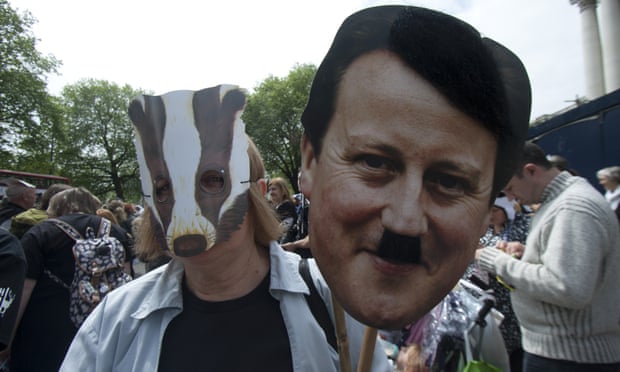There are a number of websites calling for an end to badger culls, such as:
All posts by lisa lee
Animal Rights Activists
Animal welfare and rights groups are vehemently against badger culling, instead calling on a focus on vaccination programs to eradicate bTB instead. Primarily these groups are concerned with badger welfare and conservation issues that may result from culls. Activists have been deeply involved in protests, petitions, and running websites against culling efforts, often using graphic imagery, as shown below:




Farmer Attitudes

Main attitudes from producers:
- ~90% support badger culling
- To protect cattle
- To avoid costs from a potential bTB outbreak on farm
- National Farmers’ Union (NFU) supports badger cull to be effective in reducing bTB infection rates in cattle
Petitions
Various petitions have been carried out in the past, indicating that there is indeed public support against culling. However, there appears to be no direct response from the government in changing policies or regulations to end culling despite these petitions:
- Change.org (2015)
- 3,391 signatures
- Stop the Cull (2013)
- 304,255 signatures
- Resulted in mandatory Parliamentary debate and vote
- MPs voted overwhelmingly to end cull, but no action by government to stop pilot culls
- 38 Degrees (2012)
- 97,057 signatures
Questionnaires about Badger Culling

Attitudes toward badger culling appear to differ in terms of location in the UK and when the questionnaires were conducted.
Public opinions in Glastonbury and York in 1999, through questionnaires (White and Whiting, 2000):
- Preferred no culling
- Widespread culling least favoured
- Knowledge about culls affected opinions
- More knowledge about culls -> greater cull preference due to human health concerns and economic costs to farmers
- Less knowledge about culls -> primarily concerned with badger welfare and conservation
Public opinions in Wales in 2015, through questionnaires (Enticott, 2015):
- 63% preferred vaccination over culling
- Overall, slight majority agreed with culling to control bTB
- Most felt that the current scientific reports about cull effectiveness were not adequate
Public Opinion

There appears to be variation in support for badger culling from the public, depending on the different regions of Great Britain. In general, the public opinion has been based on:
- Impact of bTB in different regions
- Amount of knowledge about the situation
- Scientific reports available
- Concern for badger welfare
- Positive outlook on badgers from British literature
Badgers in British Literature
There is a positive outlook on badgers in the English literature, reflecting the public image of badgers as wise, useful animals (Lodge and Matus, 2014). One prominent example is Mr. Badger from ‘The Wind in the Willows’.

Defra (2011)

According to a meeting held between numerous scientific experts at the Department of Environment, Food, & Rural Affairs (Defra), in order for a badger cull to be effective:
- Cull rate needs be at least 70%
- Occurs for min. 4 years
- Encompasses min. 150 square km
Predicted net benefit after a decade?
- 16% decrease in bTB on average
However, is this net benefit enough to be able to control bTB? There are conflicting opinions among the public. Farmers from the National Farmers’ Union support the cull and argue this reduction in bTB is enough, whereas animal rights activists such as from the Badger Trust cite badger culling as ineffective.
Economics

Since 2014, £63 million has been contributed by the government to deal with bTB not including research aspects (Lodge and Matus, 2014). Over the next decade, costs of bTB control are predicted to exceed £1 billion.
To fully understand net cost or benefit of bTB control by badger culling, one needs to consider costs of:
- bTB for livestock industries
- Losses from culled cattle to farmers -> 26,000 cattle slaughtered in 2011
- Average cost to bTB infected farm = £34,000
- Harmed relationships with trading partners
- Losses from culled cattle to farmers -> 26,000 cattle slaughtered in 2011
- Research
- Scientific trials -> ~£50 million
- Vaccine development
- Badger culls
- Free-shooting -> done by farmers, at no cost to government except policing
- Trapping -> labour-intensive
- Gassing -> requires special equipment
According to mathematical models by Smith et al. (2007), badger culling will have overall immediate net costs when culls occur at 70% rates (currently set as target by government), with a net benefit only occurring 1o years after culling.
Here are some quick stats:

Perturbation Effect
One reason that badger culling is thought to be ineffective is due to the perturbation effect, which results in surrounding areas outside of the culled region to have higher incidences of bTB infection.
This diagram below shows how the perturbation effect works:
